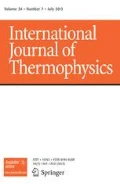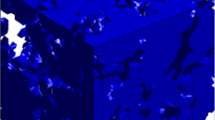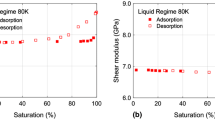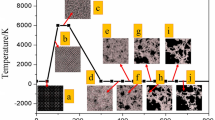Abstract
This study comprehensively analyzes the mean free path of gas molecules and gaseous thermal conductivity in confined nanoporous structures through a wide range of temperatures and pressures. A simplified unit cell cubic array structure of nanospheres is used to correlate microstructure features with specific surface area and density of nanoporous materials. Zeng’s model is used to describe the mean free path of the gas molecules and the gaseous thermal conductivity in confined nanoporous structures, and experimental gaseous thermal conductivity data from the literature is used to validate the model. The results show that a material’s nanoporous structure features are directly related to specific surface area and density. The mean free path of gas molecules in a confined nanoporous structure decreases with increasing specific surface area and density. Thus, nanoporous materials with a relatively high specific surface area and a higher density are more favorable for confining gaseous thermal conductivity in nanopores. This work shows that \(p=10^{4}\hbox { Pa}\) and \(10^{6}\hbox { Pa}\) are two characteristic pressures at ambient temperatures for the investigated silica aerogel materials. When \(p<10^{4}\hbox { Pa}\), the mean free path of the gas molecules remains constant with varying pressure, while gaseous thermal conductivity approaches zero due to the restrictive effect of the nanoporous structure and the diluted gas molecules. When \(\hbox {p}>10^{6}\hbox { Pa}\), the limiting effect of the nanoporous structure on the movement of gas molecules can be ignored, and so the mean free path of gas molecules in the nanoporous material approaches the mean free path of gas molecules in free space, while the gaseous thermal conductivity approaches the gaseous thermal conductivity in free space. As temperature increases, there exists a maximum value for gaseous thermal conductivity in confined nanoporous materials, but this maximum increases as pressure increases. The maximum gaseous thermal conductivity for the material is also determined in the paper.










Similar content being viewed by others
References
M.S. Douglas, M. Alok, B. Ulrich, J. Non-Cryst. Solids 225, 254–259 (1998)
J. Frick, T. Tillotson, Thin Solid Films 297, 212–223 (1997)
E.R. Bardy, J.C. Mollendorf, D.R. Pendergast, ASME J. Heat Transf. 129, 232–235 (2007)
S.Q. Zeng, A. Hunt, R. Greif, J. Non-Cryst. Solids 186, 264–270 (1995)
K. Raed, U. Gross, Int. J. Thermophys. 30, 1343–1356 (2009)
G. Lu, X.D. Wang, Y.Y. Duan, X.W. Li, J. Non-Cryst. Solids 357, 3822–3829 (2011)
X. Lu, M.C. Ardunini-Schuster, J. Kuhn, O. Nilsson, J. Fricke, R.W. Pekala, Science 225, 971–972 (1992)
S. Spagnol, B. Lartigue, A. Trombe, F. Despetis, ASME J. Heat Transf. 131, 074501–074504 (2009)
L.W. Hrubesh, R.W. Pekala, J. Mater. Res. 9, 731–738 (1994)
P.J. Burns, C.L. Tien, Int. J. Heat Mass Transf. 22, 929–939 (1979)
O.J. Lee, K.H. Lee, J.Y. Tae, J.K. Sun, K.P. Yoo, J. Non-Cryst. Solids 298, 287–292 (2002)
X. Lu, R. Caps, J. Fricke, C.T. Alviso, R.W. Pekala, J. Non-Cryst. Solids 188, 226–234 (1995)
S.Q. Zeng, A.J. Hunt, W. Cao, ASME J. Heat Transf. 116, 756–759 (1994)
G.S. Wei, Y.S. Liu, X.Z. Du, X.X. Zhang, ASME J. Heat Transf. 134, 041301–041306 (2012)
G.S. Wei, X.X. Zhang, F. Yu, J. Univ. Sci. Technol. Beijing 30, 781–785 (2008)
Y.Y. Duan, J. Lin, X.D. Wang, J.J. Zhao, CIESC J. 63, 54–58 (2012)
S.Q. Zeng, A. Hunt, ASME J. Heat Transf. 117, 758–761 (1995)
H.J. Wu, Y.D. Liao, Y.F. Ding, H. Wang, C. Peng, Heat Transf. Eng. 35, 1061–1070 (2014)
J.J. Zhao, Y.Y. Duan, X.D. Wang, B.X. Wang, J. Nanopart. Res. 14, 1024–1039 (2012)
G. Lu, X.D. Wang, Y.Y. Duan, Aerosp. Mater. Technol. 1, 1–6 (2011)
G. Lu, Y.Y. Duan, X.D. Wang, Aerosp. Mater. Technol. 1, 29–33 (2011)
J.-J. Zhao, PhD Thesis, Tsinghua University, Beijing, 2012
G. Reichenauer, U. Heinemann, H.P. Ebert, Colloids Surf. A 300, 204–210 (2007)
K. Swimm, G. Reichenauer, S. Vidi, H.P. Ebert, Int. J. Thermophys. 30, 1329–1342 (2009)
C. Bi, G.H. Tang, W.Q. Tao, J. Non-Cryst. Solids 358, 3124–3128 (2012)
C. Li, L.Y. Zhang, S.W. Qian, Thermal Science, 2nd edn. (High Education Press, Beijing, 2008), pp. 91–101
S.Q. Zeng, A. Hunt, R. Greif, ASME J. Heat Transf. 117, 1055–1058 (1995)
G.S. Wei, X.X. Zhang, F. Yu, J. Therm. Sci. Technol. 4, 107–112 (2005)
G.S. Wei, Y.S. Liu, X.X. Zhang, F. Yu, X.Z. Du, Int. J. Heat Mass Transf. 54, 2355–2366 (2011)
J.J. Zhao, Y.Y. Duan, X.D. Wang, B.X. Wang, J. Non-Cryst. Solids 358, 1303–1312 (2012)
J.H. Gong, J. Hefei Univ. Technol. 18, 143–147 (1995)
Acknowledgments
This research was financially supported by the National Natural Science Foundation of China (Nos. 51376060 and 51406052).
Author information
Authors and Affiliations
Corresponding author
Rights and permissions
About this article
Cite this article
Wei, G., Wang, L., Chen, L. et al. Analysis of Gas Molecule Mean Free Path and Gaseous Thermal Conductivity in Confined Nanoporous Structures. Int J Thermophys 36, 2953–2966 (2015). https://doi.org/10.1007/s10765-015-1942-z
Received:
Accepted:
Published:
Issue Date:
DOI: https://doi.org/10.1007/s10765-015-1942-z




